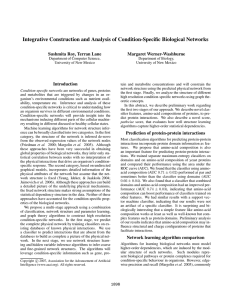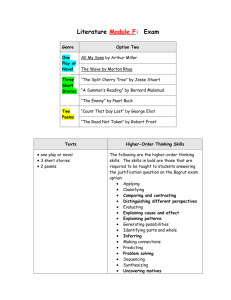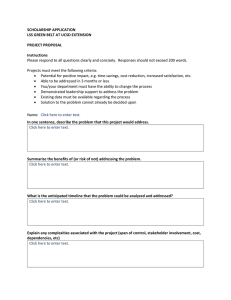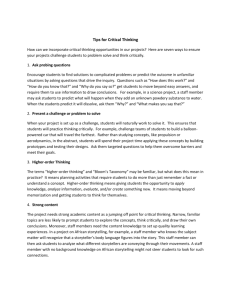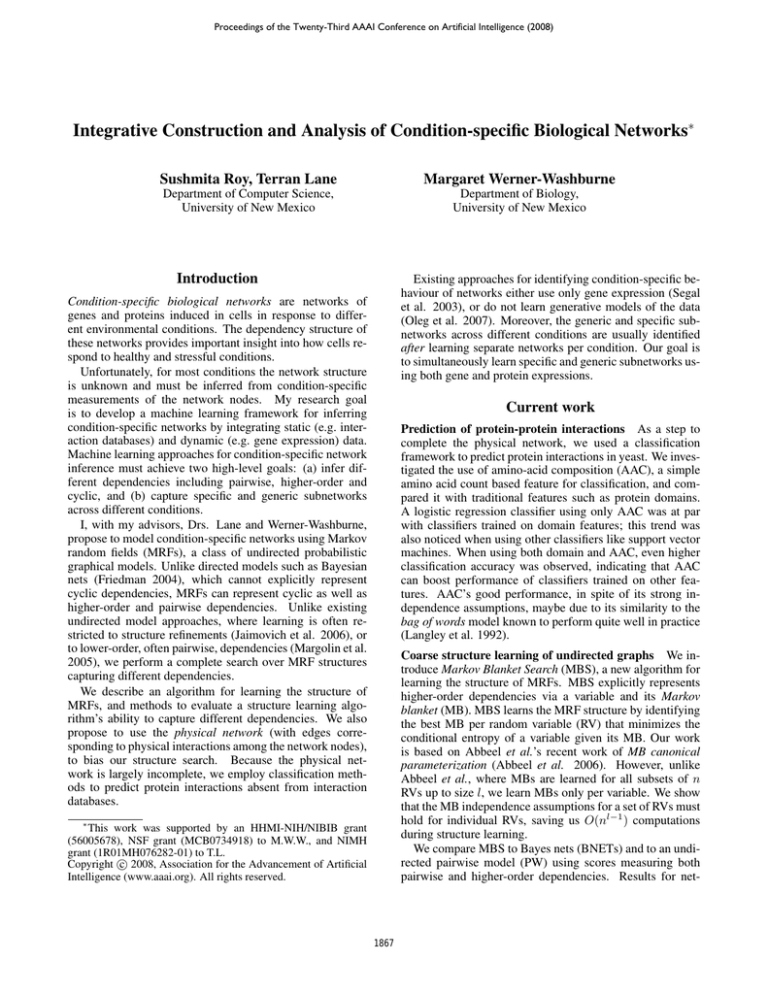
Proceedings of the Twenty-Third AAAI Conference on Artificial Intelligence (2008)
Integrative Construction and Analysis of Condition-specific Biological Networks∗
Sushmita Roy, Terran Lane
Margaret Werner-Washburne
Department of Computer Science,
University of New Mexico
Department of Biology,
University of New Mexico
Introduction
Existing approaches for identifying condition-specific behaviour of networks either use only gene expression (Segal
et al. 2003), or do not learn generative models of the data
(Oleg et al. 2007). Moreover, the generic and specific subnetworks across different conditions are usually identified
after learning separate networks per condition. Our goal is
to simultaneously learn specific and generic subnetworks using both gene and protein expressions.
Condition-specific biological networks are networks of
genes and proteins induced in cells in response to different environmental conditions. The dependency structure of
these networks provides important insight into how cells respond to healthy and stressful conditions.
Unfortunately, for most conditions the network structure
is unknown and must be inferred from condition-specific
measurements of the network nodes. My research goal
is to develop a machine learning framework for inferring
condition-specific networks by integrating static (e.g. interaction databases) and dynamic (e.g. gene expression) data.
Machine learning approaches for condition-specific network
inference must achieve two high-level goals: (a) infer different dependencies including pairwise, higher-order and
cyclic, and (b) capture specific and generic subnetworks
across different conditions.
I, with my advisors, Drs. Lane and Werner-Washburne,
propose to model condition-specific networks using Markov
random fields (MRFs), a class of undirected probabilistic
graphical models. Unlike directed models such as Bayesian
nets (Friedman 2004), which cannot explicitly represent
cyclic dependencies, MRFs can represent cyclic as well as
higher-order and pairwise dependencies. Unlike existing
undirected model approaches, where learning is often restricted to structure refinements (Jaimovich et al. 2006), or
to lower-order, often pairwise, dependencies (Margolin et al.
2005), we perform a complete search over MRF structures
capturing different dependencies.
We describe an algorithm for learning the structure of
MRFs, and methods to evaluate a structure learning algorithm’s ability to capture different dependencies. We also
propose to use the physical network (with edges corresponding to physical interactions among the network nodes),
to bias our structure search. Because the physical network is largely incomplete, we employ classification methods to predict protein interactions absent from interaction
databases.
Current work
Prediction of protein-protein interactions As a step to
complete the physical network, we used a classification
framework to predict protein interactions in yeast. We investigated the use of amino-acid composition (AAC), a simple
amino acid count based feature for classification, and compared it with traditional features such as protein domains.
A logistic regression classifier using only AAC was at par
with classifiers trained on domain features; this trend was
also noticed when using other classifiers like support vector
machines. When using both domain and AAC, even higher
classification accuracy was observed, indicating that AAC
can boost performance of classifiers trained on other features. AAC’s good performance, in spite of its strong independence assumptions, maybe due to its similarity to the
bag of words model known to perform quite well in practice
(Langley et al. 1992).
Coarse structure learning of undirected graphs We introduce Markov Blanket Search (MBS), a new algorithm for
learning the structure of MRFs. MBS explicitly represents
higher-order dependencies via a variable and its Markov
blanket (MB). MBS learns the MRF structure by identifying
the best MB per random variable (RV) that minimizes the
conditional entropy of a variable given its MB. Our work
is based on Abbeel et al.’s recent work of MB canonical
parameterization (Abbeel et al. 2006). However, unlike
Abbeel et al., where MBs are learned for all subsets of n
RVs up to size l, we learn MBs only per variable. We show
that the MB independence assumptions for a set of RVs must
hold for individual RVs, saving us O(nl−1 ) computations
during structure learning.
We compare MBS to Bayes nets (BNETs) and to an undirected pairwise model (PW) using scores measuring both
pairwise and higher-order dependencies. Results for net-
∗
This work was supported by an HHMI-NIH/NIBIB grant
(56005678), NSF grant (MCB0734918) to M.W.W., and NIMH
grant (1R01MH076282-01) to T.L.
c 2008, Association for the Advancement of Artificial
Copyright Intelligence (www.aaai.org). All rights reserved.
1867
works of known topology suggest that MBS dominates both
BNET and PW, successfully capturing higher-order, pairwise, and cyclic dependencies. On real data, MBS identifed
several higher-order structures that were not captured by PW
or BNET.
which is unrealistic for scale-free networks.
Inference of protein expression levels Our goal is to infer
condition-specific networks not only using gene expression
but also protein expression. Because protein expressions
are not readily available we must infer them from observed
gene expressions. The transcription factor (TF) protein expression can be modeled as a function of two components:
one, determined by the expression of the gene coding the
TF, and, the other, determined by expressions of the target
genes regulated by the TF. Using a structual EM-like framework (Friedman 1997), we will allow both protein and gene
expression to influence structure learning.
Measuring higher-order dependencies Algorithms for
network structure learning infer different networks depending upon the optimization criteria. For example, pairwise
models optimize dependencies among exactly two variables,
whereas higher-order models include dependencies among
three or more variables. However, scores evaluating these algorithms typically measure accuracy of pairwise dependencies, matching only individual edges between the true and
inferred networks (Margolin et al. 2005). As higher-order
dependencies are not measured, the models truely capturing
higher-order dependencies are not identified.
We introduce novel scores that measure higher-order dependencies in inferred networks. We assume meaningful
higher-order dependencies to correspond to subgraphs of the
true network, true subgraphs. We quantify the match using
different higher-order scores measuring how well edges or
vertex degrees of the true subgraphs are captured. Unlike
pairwise scores, these scores compare sets of edges from the
true subgraphs against the inferred network.
For example, we evaluate vertexPdegree match using a reP
v∈Vg hv
call score: RVSG = g∈St w̄g P
hv +mv , where St de-
Learning condition-specific networks A simple approach for identifying condition-specific networks is to learn
separate networks on data from separate conditions, and
compare the individual networks. We hypothesize that the
networks learned per condition share many components.
Therefore, learning separate networks not only reduces the
data available for structure learning but also makes the structure learning algorithm unaware of the information shared
between the conditions.
Simultaneous learning of networks for multiple tasks has
been addressed in both supervised (Geiger and Heckerman
1991) and unsupervised learning (Meila and Jordan 2000).
Because we know the identity of the condition variable,
condition-specific networks are similar to multi-nets in supervised learning. However, unlike multi-nets, we are interested in both discriminating (specific) and generic subnetworks across conditions. Furthermore, we require the
graphs be undirected. We aim to extend existing multi-net
frameworks for simultaneous identification of generic and
condition-specific subnetworks.
v∈Vg
notes a set of subgraphs of a particular type such as cliques
|V |
or cycles, w̄g = P g |Vf | , Vg is the vertex set of subgraph
f ∈St
g, hv and mv are the number of neighbours of v, matched
and missed, respectively. These scores range in [0, 1], and
equal 1 when all subgraphs are matched perfectly. Comparison of different algorithms using both these and standard pairwise scores showed that higher-order models capture both higher-order and pairwise dependencies better than
pairwise models.
References
Abbeel, P., et al. 2006. Learning factor graphs in polynomial time
and sample complexity. JMLR 7:1743–1788.
Friedman, N. 1997. Learning belief networks in the presence of
missing values and hidden variables. In ICML.
Friedman, N. 2004. Inferring cellular networks using probabilistic graphical models. Science 303:799–805.
Geiger, D., and Heckerman, D. 1991. Advances in probabilistic
reasoning. In UAI.
Jaimovich, A., et al. 2006. Towards an integrated protein-protein
interaction network: a relational markov network approach. Journal of Comp. Biol. 13(2):145–164.
Langley, P., et al. 1992. An analysis of bayesian classifiers. In
National Conference on Artificial Intelligence, 223–228.
Margolin, A., et al. 2005. Aracne: An algorithm for the reconstruction of gene regulatory networks in a mammalian cellular
context. BMC Bioinformatics (Suppl 1): S7.
Meila, M., and Jordan, M. I. 2000. Learning with mixtures of
trees. JMLR 1:1–48.
Oleg, R., et al. 2007. Similarities and differences of gene expression in yeast stress conditions. Bioinformatics 23(2):e184–e190.
Segal, E. et al. 2003. Module networks: identifying regulatory
modules and their condition-specific regulators from gene expression data. Nat Genet 34(2):166–176.
Future plan
Incorporating biological prior for network structure
learning Our algorithm currently infers the network structure de-novo without incorporating any biological knowledge. This makes structure learning slow and produces
dependencies that may not all be biologically meaningful.
We will guide our structure search by incorporating prior
knowledge from existing protein interaction and ontology
databases. These databases provide prior information about
meaningful associations between RVs, which can be represented as edges of a database-specific graph of RVs. We can
combine these database-specific graphs into a single multigraph, with multi-edges representing evidence from multiple databases. The number of edges between two RVs can
provide prior information of the strength of their interaction.
The evidence multi-graphs also provides per-variable regularization allowing different RVs to have neighbourhoods of
different sizes. In fact, our empirical results indicate that the
neighbourhood size limit commonly used in network structure search often forces the graph topology to be regular,
1868




